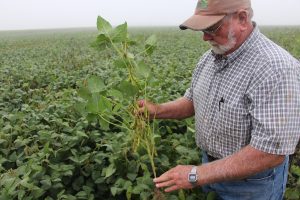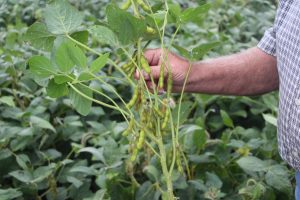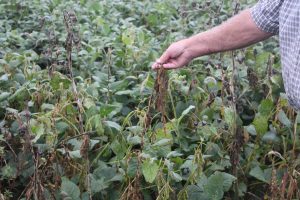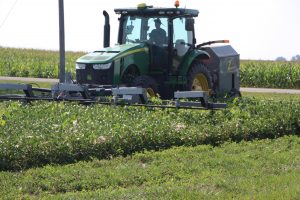Agronomy, Homepage Slider, Specialty
Organic Soybean Production and Weed Control
By Dusty Sonnenberg, CCA, Ohio Field Leader: a project of the Ohio Soybean Council and soybean checkoff.
One of the biggest barriers for farmers considering the transition to organic crop production is weed control. For Dave Shively of McClure, Ohio, weed control was one of the things that drew his interest to organic farming practices. “I have been raising crops organically for 16 years,” said Shively. “Before transitioning to organic grain production, I was getting tired of paying for conventional weed spraying and not seeing the results I wanted. I knew that it could not be good for the environment.”
Shively says that if a farmer is going to be successful with organics, they must be committed to the system. “My wife first had an interest in edamame beans, so as we looked into those, I talked to some guys who were farming organically. That led to me try growing organic on a small scale to see if I could manage it,” said Shively. “We had a lot of ground in alfalfa and hay for several years that aided in the three-year organic certification transition. I asked a lot of questions to guys who were growing organically, and then I started with one field. The next year I transitioned another field. Organic production takes time and management. A farmer needs to be committed to the system.”
A good organic system involves protecting the soil with cover crops. It also involves using tillage to control weeds. “We do a lot of tillage early in the season,” said Shively. “I always want my ground to be covered, so I plant a cover crop mix in the fall, and then will chop it in the spring and work it in to help break down the residue and also help control any weeds. The spring tillage will level out any ridges that remain from cultivating the previous crop.”
Weed control is one of the more time-consuming activities in organic production. In season tillage for weed control is a regular activity. “Just before we plant, and then again right after planting I will run a rotary hoe 2 to 3 times to lightly take out any small weeds that are emerging. It helps the stir the surface of the soil and get some of those weeds to emerge, and then get them out before they get too big,” said Shively. “We will plant the regular crop a little deeper than normal, and at a little higher seeding rate knowing that we may thin it during the cultivation passes. Once the crop emerges, it is important to have a cultivator with good spoons, and now a lot of guys are even going to the tine cultivators. Typically, most of the weed pressure comes in the rows. We can cultivate out the weeds between the rows, but in-row weeds are our biggest problem.”
Shively raises organic corn, soybeans, and wheat; along with some alfalfa and red clover. “This year I had a one of the nicest wheat crops I have raised organically,” said Shively. “With my production system, typically soybeans will not be harvested until later in October, so getting a good stand of wheat established by that time in the fall of the year can be a challenge. Last year because we had some prevent plant acres, I was able to address some weed issues, and get the wheat planted timely and a very nice stand established.”
This year Shively is raising an organic, food grade, seed stock bean for Albert Lea Seeds. “This field is soybeans back to soybeans. It is an Albert Lea Seed variety that was a food grade bean in the conventional market, but they had foundation seed, and these will actually be considered organic seed for them for next year. They are a 3.1 maturity, and are supposed to be above 42% protein according to the literature,” said Shively. “They will be delivered to Hirzel Farms to be cleaned for Albert Lea and then used for seed next spring.”
“This was the first year I have grown beans back to beans. Normally it would have been an organic corn field, but the corn market has been so depressed that I decided to go back to soybeans,” said Shively. “My normal crop rotation is corn, beans, wheat, and hay. Occasionally I will also grow organic seed oats. Organic growers are typically very rotational with a small grain and a clover or cover crop included in the rotation. We grow our own nitrogen.”
When it comes to pest control, Shively has an organic philosophy. “Let the good bugs eat the bad ones,” said Shively. “I think at times the insecticide that is sprayed on crops kills all the good bugs that would normally eat and help control the bad ones. I have been fortunate, and not had significant insect pressure that has caused a problem.”
Organic crop production involves being a good steward to the environment and to the neighbors. Weed control is always a concern. “A few years ago I had an organic wheat field with thistle patches that got really bad and were going to go to seed and spread if I did not do something. Unfortunately, they were so thick across the field that I went ahead and mowed the field down, wheat and all to control the thistles,” said Shively. “I obviously did not want to do that, but I also did not want the thistles to go to seed, or spread to the neighbors. This year I had a ragweed and velvet leaf problem in a field of beans. I needed to find a rescue treatment, because the regular cultivation I do did not control the weeds late in the season. I had heard about some guys who had a tool that used electricity to kill the weeds and make the seed not be viable. I called around and got the name of Seth Stutzman from the Plain City area, who has The Weed Zapper. I contacted a couple other organic growers in the area, and together we rounded-up enough acres to justify him bringing his equipment up to run for us.”
Weed control is always a concern. “A few years ago I had an organic wheat field with thistle patches that got really bad and were going to go to seed and spread if I did not do something. Unfortunately, they were so thick across the field that I went ahead and mowed the field down, wheat and all to control the thistles,” said Shively. “I obviously did not want to do that, but I also did not want the thistles to go to seed, or spread to the neighbors. This year I had a ragweed and velvet leaf problem in a field of beans. I needed to find a rescue treatment, because the regular cultivation I do did not control the weeds late in the season. I had heard about some guys who had a tool that used electricity to kill the weeds and make the seed not be viable. I called around and got the name of Seth Stutzman from the Plain City area, who has The Weed Zapper. I contacted a couple other organic growers in the area, and together we rounded-up enough acres to justify him bringing his equipment up to run for us.”
The Weed Zapper’s overall concept is relatively simple. It can be used once the beans have canopied and the weeds begin to emerge above the canopy. The boom height is run a couple inches above the soybean canopy, and only comes in contact with the weeds, sending a charge through the weed to kill it, but leaving the crop unharmed. The Weed Zapper has two rolling coulters that ground the system. It completes the circuit when the power from the boom brushes across the top of the weed, and then flows through it into the soil and is grounded. The cell walls inside the weeds rupture when 15,000 volts of electricity flow through the plant, and it kills it down to the roots. The longer the boom is in contact with the weeds, or the electricity flows, the more effective it is a killing the weed. “It is not something that can get all the weeds, but works well as a rescue treatment for late season outbreaks,” said Shively. “After he went across the field, the weeds and seed pods all shriveled up and died. This tool is also gaining popularity with conventional soybeans in areas where they have outbreaks of herbicide resistant weeds.”